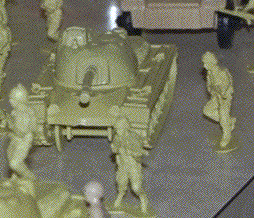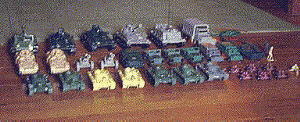
Copyright 2002 T. Sheil & A. Sheil All Rights Reserved

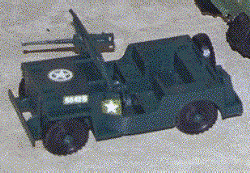
Jeep: the Willys Jeep was introduced to the US Army just before the American forces entered World War II. It proved to be indispensable. Jeeps were able to traverse all kinds of terrain and perform a variety of tasks. Rugged and reliable, the Jeep served as troop carried, recon vehicle, staff car and prime mover for towing light artillery. It was a complete success.
During the Vietnam era, the Jeep was replaced by the Ford "Mutt.' Though called a "Jeep" by troops, it had its flows. Most notorious was a high center of gravity which made it unstable and prone to tip. (Two friends of mine were nearly killed in such an incident during a chow run. One was seriously injured.) In 1984, the Mutt was replaced by the current "Humm-Vee", a wide, truck-like vehicle.
For the Army men, the Jeep is essential. Jeeps were packed into bags of troops and playsets, and remain in production. They were often accompanied by a light cannon, be it an antitank cannon like the 37MM and 57mm towed guns, a light howitzer similar to the 75mm gun, or a 105mm gun. Scale ranged from small offscale pieces of about 1/48 scale on up to full-sized 1/32 and 1/24 models. HummVees are present, but in the world of plastic soldiers the Jeep will never fall by the wayside.
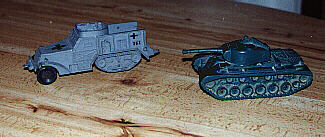
The Half-Track: the standard armored personnel carrier of World War II was the half-tracked armored truck. It was a vehicle with wheels and tires in front, and a tracks in the back. The front wheels were for steering. Half-tracks were used in several armies of the era, notably the US and allied forces, and the Germans. Even as the war began, the shortcomings of the half-track had become obvious to US military experts, and plans were made for a fully-tracked personnel carrier. Nonetheless, the half-track survived into the early 1950s.
The M3 and M4 series of half-tracks may have been less the ideal, but they were adapted to a variety of tasks. Along with personnel carried, these iron trucks were fitted as heavy mortar carriers, antiaircraft gun platforms and tank destroyers. The antiaircraft version ,called the M-16, had a set of four fifty-caliber machine guns mounted in a swivelling turret in the back. Tank destroyers were fitted initially with the underpowered French 75mm gun. Later they received the 105mm howitzer, making them ideal for both tank-busting and as self-propelled artillery.
For Army Men, the half-track is the quintessential armored personnel carrier. It can go almost anywhere a tank can go, and it carries men and heavy machine-guns. Few of the tank destroyer versions ever made their way into soft plastic. Half tracks can also tow light artillery. Fully-tracked armored personnel carriers have been available in plastic since the 1950s, but their presence is not a threat to the ever-present, classic half-track.
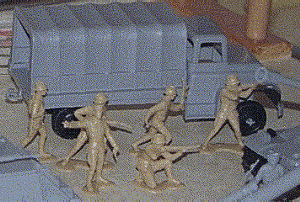
The standard 2 1/2 ton truck has been in Army service before World War II. Though it has undergone many improvements, it remains a good basic vehicle for carrying supplies and personnel. Trucks were useful for moving almost anything. In World War II, the US trucks were smaller than their German counterparts, but superior mechanical reliability and the capability of running off-road gave the American vehicles a definite edge. They aren't the most comfortable things to ride, but they will get you and your equipment where you have to go.
For plastic Army Men, the 2 1/2 truck is a staple of the motor pool. Reliable and able to run in some pretty rough terrain, it is used to move troops and towed artillery. No plastic battlefield would be complete without them.
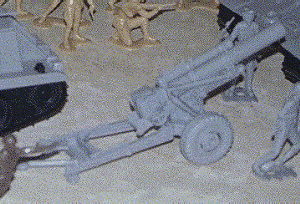
The Field Gun: artillery has been around since the days of catapults and ballistae. The use of gunpowder in the Middle Ages evolved into mobile field guns which are considered essential to modern combat. Heavy artillery had many uses, but it had one shortcoming: time. It took tremendous effort to bring heavy artillery into range to strike a fast-moving enemy. There were many instances where the speed of battle negated the use of the big guns. To solve the problem, armies developed lighter field guns which could be brought into battle rapidly, enabling troops to bring artillery support in a fast-moving situation.
Light artillery did not have the punch of the big guns, but the speed with which it could be deployed made a difference. Its development resulted in various types of horse-drawn and "portable" guns. Some were small enough that they could be taken down and packed on mules or camels. One of the biggest innovations in light gunnery was the French 75mm gun. It had a recoil-absorbing system that made it idea as light and medium artillery. Most of the light guns of the time were howitzers, used for high-angle firing. Guns like the French 75 could also be used in a direct-fire role.
The aftermath of World War I left in its wake the problem of armored vehicles. To provide an anti-armor capability for infantry and cavalry units, small high-velocity guns were developed to serve as anti-tank weapons. They were intended to be towed on trucks or small prime movers, and to accompany non-armored units into battle. A,mong the best-known of the towed antitank guns were the US 37mm and 57mm guns, the British 2 and 6 pounder (the six pounder was a 57mm gun), and German 20mm, 37mm and 50mm PAK antitank guns. Development of traditional light field artillery also continued, with the French 75, airborne American 75mm and 105mm howitzers, and German "infantry guns" of 75mm. The towed antitank gun faded out by the early 1950s. Wartime development of recoilless rifles and antitank rockets like the bazooka, panzerschreck, PIAT gun and panzerfaust made the towed antitank gun obsolete.
Light howitzers were also superseded. Though some light guns remained in airborne units until the 1960s, most armies switched to better mortars and other rocket-type weapons. Air-portable 105mm guns are the only light howitzers used by modern armies. Mobility is often a matter of using self-propelled artillery or calling in attack helicopters.
For our plastic Army Men, the towed cannon has a permanent place. Towed by jeeps, trucks, or half tracks, it serves mainly as a direct-fire weapon against enemy troops and vehicles. The old towed guns will never fade out in the wars on the plastic battlefield.
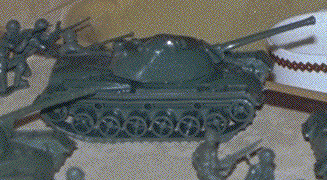
Tanks: the epitome of vehicles for plastic soldiers, the tank is the star of the battlefield. Since it first appeared in World War I, it has been the wunderkind of toy warfare. In the real world, the tank had an uncertain development. The first tanks were little more than lightly armored machine-gun and light artillery vehicles. The Mk 1 series, a rhomboidal contraption with guns mounted in side sponsons, struck fear into German forces. Its slow and ponderous movement made it an easy target for artillery, but it changed warfare forever. France's small Renault Char'D was a lighter, faster vehicle which remained in the inventory of some countries into World War II. US, British and Russian tank development were a catch-as-catch - can things throughout the 1920s and 1930s. Only France and Germany had respectable armor-development programs. The war saw several countries armor-programs caught short. This led to early disasters for the British in 1940 in Europe and Africa. France was caught short, not for the quality of its tanks, but the lack of a good armored warfare doctrine. Russia, whose tank development was awkward, found themselves far outclassed by the German armor and tactics.
The US was able to tip the scales in its favor temporarily, thanks to the M3 Lee / Grant and M4 Sherman tanks. When these appeared with British forces in North Africa, they caught the lighter-armored German forces off guard. The same happened when Russia set loose its well-designed T34 and heavy KV 1 tanks. Germany already had a response: the Tiger and the Panther, not to mention up-armored and up-gunned Panzer 4s. By war's end, it was heavy tanks scoring the most: the US M26 Pershing, British Comet and Churchill, Soviet ISII and German super-sized King Tiger and Jagtiger tanks.
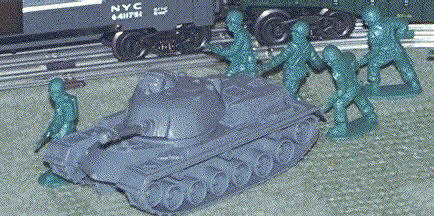
Postwar development saw the emergence of newer tanks. The M26 remained for a while, eventually replaced by the M46 and M47 medium tanks. Britain produced the excellent Centurion tank. Russia developed the heavy JS series of tanks, and introduced the T44 and the excellent T54 / T55. The final tank of the 1950s was the US M48, one of the best tanks ever build and still in use.
Tank development never stopped. Russia expanded on its T/54 with the T/62, T72 and T80. Britain brought out an entirely new tank called the Chieftain, while the US brought the updated M48 known as the M-60 series. It wasn't until the 1980s that a radically new tank showed up, that being the US M1 Abrams.
For plastic armies, tank development has been...well, weird. Lido used to pack an undersized Centurion with its troops, while Auburn and Ideal went with the M26 / M46 and Tim Mee seized on the M-48. Of them all, the M-48 has endured. It is found in every imaginable color and is still packed with toy soldier sets. A few companies have brought forth undersized models of modern tanks, but the M-48 remains the most common plastic toy tank.
